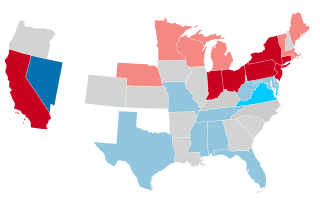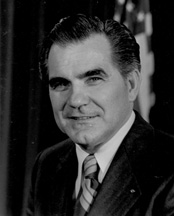
Presidential elections were held in the United States on November 5, 1872. Incumbent President Ulysses S. Grant, the Republican nominee, defeated Democratic-endorsed Liberal Republican nominee Horace Greeley.
The Massachusetts Republican Party (MassGOP) is the Massachusetts branch of the U.S. Republican Party.

Alfred Henry Littlefield was an American businessman and politician. He was a member of the Rhode Island House of Representatives and the Rhode Island Senate, and was the 35th Governor of Rhode Island.

The 1904 New York state election was held on November 8, 1904, to elect the governor, the lieutenant governor, the Secretary of State, the state comptroller, the attorney general, the state treasurer, the state engineer, the chief judge and an associate judge of the New York Court of Appeals, as well as all members of the New York State Assembly and the New York State Senate.

The 1898–99 United States Senate elections were held on various dates in various states. As these U.S. Senate elections were prior to the ratification of the Seventeenth Amendment in 1913, senators were chosen by state legislatures. Senators were elected over a wide range of time throughout 1898 and 1899, and a seat may have been filled months late or remained vacant due to legislative deadlock. In these elections, terms were up for the senators in Class 1.

The 1880–81 United States Senate elections were held on various dates in various states, coinciding with the presidential election of 1880. As these U.S. Senate elections were prior to the ratification of the Seventeenth Amendment in 1913, senators were chosen by state legislatures. Senators were elected over a wide range of time throughout 1880 and 1881, and a seat may have been filled months late or remained vacant due to legislative deadlock. In these elections, terms were up for the senators in Class 1.

The 1866–67 United States Senate elections were held on various dates in various states. As these U.S. Senate elections were prior to the ratification of the Seventeenth Amendment in 1913, senators were chosen by state legislatures. Senators were elected over a wide range of time throughout 1866 and 1867, and a seat may have been filled months late or remained vacant due to legislative deadlock. In these elections, terms were up for the senators in Class 3.

The 1972 United States Senate election in Virginia was held on November 7, 1972. Republican U.S. Representative William L. Scott defeated incumbent Democratic Senator William Spong Jr. Scott was the first Republican U.S. Senator from Virginia to be elected in over a century, as the most recent Republican Senator was John F. Lewis, who had served during the Reconstruction era until 1875.

The 1878 Vermont gubernatorial election took place on September 3, 1878. Incumbent Republican Horace Fairbanks, per the "Mountain Rule", did not run for re-election to a second term as Governor of Vermont. Republican candidate Redfield Proctor defeated Democratic candidate W. H. H. Bingham to succeed him.
The 1950 Massachusetts general election was held on November 7, 1950, throughout Massachusetts. Primary elections took place on September 19.

The 1936 Massachusetts gubernatorial election was held on November 3, 1936.

The 1920 Tennessee gubernatorial election was held on November 2, 1920. Republican nominee Alfred A. Taylor, brother of former governor Robert Love Taylor, defeated Incumbent Democratic governor Albert H. Roberts with 54.9% of the vote.

The 1902 Rhode Island gubernatorial election was held on November 4, 1902. Democratic nominee Lucius F. C. Garvin defeated incumbent Republican Charles D. Kimball with 53.99% of the vote.

The 1896 Rhode Island gubernatorial election was held on April 1, 1896. Incumbent Republican Charles W. Lippitt defeated Democratic nominee George L. Littlefield with 56.40% of the vote.

The 1863 Connecticut gubernatorial election was held on April 6, 1863. It was a rematch of the 1860 Connecticut gubernatorial election. Incumbent governor and Republican nominee William Alfred Buckingham defeated former governor and Democratic nominee Thomas H. Seymour with 51.64% of the vote.

The 1884 North Carolina gubernatorial election was held on November 4, 1884. Democratic nominee Alfred Moore Scales defeated Republican nominee Tyre York with 53.80% of the vote.

The 1882 Rhode Island gubernatorial election was held on April 5, 1882. Incumbent Republican Alfred H. Littlefield defeated Democratic nominee Horace A. Kimball with 64.78% of the vote.

The 1880 Rhode Island gubernatorial election was held on April 7, 1880. Republican nominee Alfred H. Littlefield defeated Democratic nominee Horace A. Kimball with 44.82% of the vote.

A general election was held in the U.S. state of Wyoming on Tuesday, November 2, 1926. All of the state's executive officers—the Governor, Secretary of State, Auditor, Treasurer, and Superintendent of Public Instruction—were up for election. Republicans narrowly picked up the governorship and solidified their control on the other statewide offices, increasing their margin of victory in each race.
The 1944 Massachusetts general election was held on November 7, 1944, throughout Massachusetts. Primary elections took place on July 11.


















